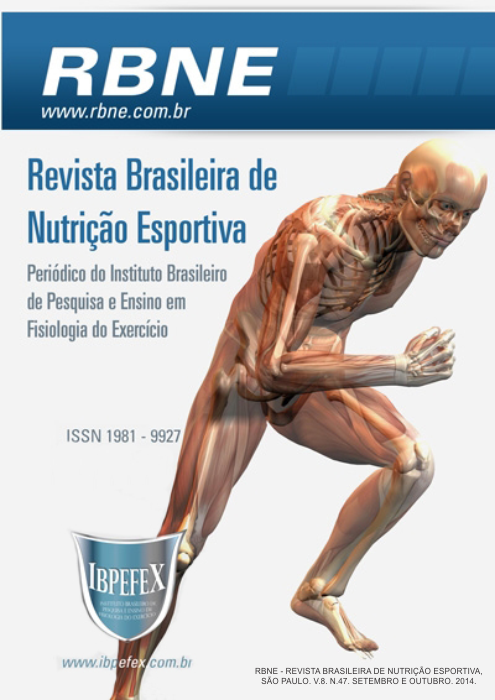Evaluation of caloric consumption and distribution of macronutrients on usual feeding for dancers of Cia Dança Sesiminas regarding their nutritional requirements
Abstract
The dance requires the dancers a balanced diet that meets both your everyday needs as those required by the activities and allowing good physical recovery and improved performance. The study aims to assess the adequacy of energy intake andmacronutrients distribution of the diet of dancers from Cia de Dança Sesiminas in relation to their daily needs. The sample consisted of 10 dancers in which they conducted anthropometric measurements such as weight, height and skinfold for BMI and percentage of body fat and food intake was assessed by recording 72 hours. The majority of the sample was classified as eutrophic according to WHO. The body fat percentage of the group varied between very good and reasonable, with the highest percentage among women. The energy consumption was lower than most individual needs and carbohydrate consumption also lower than the recommendations, the same happening to the protein intake. The group has just lipid intake within recommended levels, but a more detailed evaluation of the quality of them is required. This result confirms, as in other studies, the need for nutritional intervention for this population, and further studies about real energy needs of dancers.
References
-American Dietetic Association -ADA. Position of the American Dietetic Association, Dietitians of Canada, and American College of Sports Medicine: Nutrition and athletic performance. Med Sci Sports Exerc. Vol. 32. Num. 12. 2000. p. 2130-2145.
-Costa Uzurdiaga, A. Alimentación y gasto energético de lós bailarines. Estudis escènics: quaderns de l’Institut Del Teatre. Num 36. 2009. p. 424-431.
-Damasceno, V.O.; Lima, J.R.P.; Vianna, V.R.A.; Novaes, J.S. Tipo físico ideal e satisfação com a imagem corporal de praticantes de caminhada. Rev Bras Med Esporte. Vol. 11. 2005. p. 181-186.
-Kreider, R.B.; Wiborn, C.D.; Taylor, L.; Campbell, B.; Almada, A.L.; Collins, R.; Cooke, M.; Earnest, C.P.; Greenwood, M.; Kalman, D.S.; Kerksick, C.M.; Kleiner, S.M.; Leutholtz, B.; Lopez, H.; Lowery, L.M.; Mendel, R.; Smith, A.; Wildman, R.; Willoughby, D.S.; Ziegenfuss, T.N.; Antonio, J. ISSN exercise & Sport nutrition review: research & recommendations. Journal of the Internacional Society of Sports Nutrition. 2010.
-Loucks, A.B. Energy balance and body composition in sports and exercise. Journal of Sports Sciences. Vol 22. 2004: p. 1-14.
-Moreira, A.J.; Nicastro, H.; Cordeiro, R.C.; Coimbra, P.; Frangella, V.S. Composição corporal de idosos segundo a antropometria. Rev Bras Geriatr Gerontol. Vol. 12. num 2. 2000.
-Prado, W.L.; Botero, J.P.; Guerra, R.L.F.; Rodrigues, C.L.; Cuvello, L.C.; Dâmaso, A.R. perfil antropométrico e ingestão de macronutrientes em atletas profissionais brasileiros de futebol de acordo com suas posições. Rev Bras Med Esporte. Vol. 12. Num 2. 2006. p. 61-65.
-Ribeiro, L.G.; Veiga, G.V. Imagem corporal e comportamentos de risco para transtornos alimentares em bailarinos profissionais. Rev Bras Med Esporte. Vol. 16. Num 2. 2010. p. 99-102.
-Rojas, E.M.; Urrutia, A.R.G. Estado Nutricional de bailarinas de ballet clássico, área metropolitana de Costa Rica. Rev costarric salud pública. San José. Vol 17. Num 33. 2008.
-World Health Organization Expert Committee. Physical status: the use and interpretation of anthropometry. WHO Technical Report Series. Núm. 854. Geneva. WHO. 1995. p. 263-334.
Authors who publish in this journal agree to the following terms:
- Authors retain the copyright and grant the journal the right of first publication, with work simultaneously licensed under the Creative Commons Attribution License BY-NC which allows the sharing of the work with acknowledgment of the authorship of the work and initial publication in this journal.
- Authors are authorized to enter into additional contracts separately for non-exclusive distribution of the version of the work published in this journal (eg, publishing in institutional repository or book chapter), with acknowledgment of authorship and initial publication in this journal.
- Authors are allowed and encouraged to post and distribute their work online (eg, in institutional repositories or on their personal page) at any point before or during the editorial process, as this can bring about productive change as well as increase impact and impact. citation of published work (See The Effect of Free Access).






